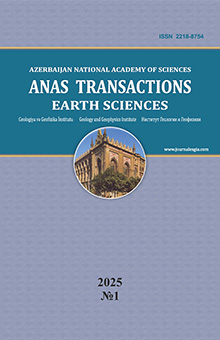Possible positive effects of chronic low-dose ionizing radiation on human life-span in Talysh, Azerbaijan
Aliyev Ch.S.1, Kamilova N.M.2, Mahmudova F.F.1, Baghirli R.J.1, AliyevaA.R.1
1 Ministry of Science and Education of the Republic of Azerbaijan, Institute of Geology and Geophysics, Azerbaijan 119, H.Javid ave., Baku, AZ1143: aliyev.chingiz47@gmail.com
2 Azerbaijan Medical University, Ministry of Health of the Republic of Azerbaijan, Azerbaijan 100, Mardanov Qardashlar str., Baku, AZ1078
DOI: 10.33677/ggianas20240100115
Summary
Radiation hormesis is the hypothesis that low doses of ionizing radiation (within the region of and just above natural background levels) are beneficial, stimulating the activation of repairing mechanisms that protect against disease, that are not activated in absence of ionizing radiation. The paper describes research results supporting hormesis through exposure to low-dose ionizing radiation conducted in the Talysh region of Azerbaijan. According to the International Committee on Radiation Protection, 40-75% of total human exposure to natural radioactive sources comes from radon and its decay products. Radiometric studies covered five districts of the Talysh region: Masalli, Lankaran, Astara, Yardimli and Lerik. The volume activity of radon in residential areas was measured with radon Scout and radon Scout Plus radiometers from SARAD. Based on the obtained results, maps of the distribution of radon volume activity are constructed separately for each region. According to this map, the Lerik district, known for its long-lived inhabitants, is characterized by a relatively high level of radon. The ECG (electrocardiograph) of cardiac activity is written in the modern cardiograph Cardi Max Fx 8222 produced by the Japanese company Denshi Fukuda. The results of the research showed that there is a certain correlation between the level of radon in homes and life expectancy. According to the current regulatory document, the indoor radon volume activity should not exceed 200 Bq/m³. Based on research results, in villages where centenarians are living, the level of indoor radon varies between 100-200 Bq/m3, averaging 150 Bq/m3.
Keywords: radiation hormesis, Talysh, radon volume activity, life expectancy, human health
REFERENCES
Boice J.D.Jr. The linear nonthreshold (LNT) model as used in radiation protection: An NCRP update. International Journal of Radiation Biology, Vol. 93, No.10, 2017, pp. 1079-1092, https://doi.org/10.1080/09553002.2017.1328750.
Cohen В. Relationship between exposure to radon and various types of cancer. Health Physics, Vol. 65, No. 5, 1993, pp. 529-531.
Cui J., Yang G., Pan Z., Zhao Y., Liang X., Li W., Cai L. Hormetic focus on the immune system and its clinical implications. International Journal of Molecular Sciences, Vol. 18, No.2, 2017, pp. 1-12.
Feyzullayev A.A., Aliyev Ch.S., Baghirli R.J., Mahmudova F.F. Assessment of indoor and outdoor radon concentrations in Talysh, Azerbaijan. ANAS Transactions, Earth Sciences, No. 1, 2021, pp. 43-46, DOI:10.33677/ggianas20210100053.
ICRP Publication. The 2007 Recommendations of the International Commission on radiological protection. Vol. 37, No. 2-4, 2007, 1-332 p., DOI: 10.1016/j.icrp.2007.10.003.
Kreuzer M., Auvinen A., Cardis E., Durante M., Harm-Ringdahl M., Jourdain J.R., Madas B.G., Ottolenghi A., Pazzaglia S., Prise K.M., Quintens R, Sabatier L, Bouffler S. Multidisciplinary European Low Dose Initiative (MELODI): Strategic research agenda for low dose radiation risk research. Radiation and Environmental Biophysics, Vol. 57, No. 1, 2018, pp. 5-15, DOI: 10.1007/s00411-017-0726-1.
National Research Council of the National Academies. Health risks from exposure to low levels of ionizing radiation: BEIR VII Phase 2, 2006, 442 p.
Seibold P., Auvinen A., Averbeck, D., Bourguignon M., Hartikainen J.M., Hoeschen C., Laurent O., Noel, G., Sabatier L., Salomaa S., Blettner M. Clinical and epidemiological observations on individual radiation sensitivity and susceptibility. International Journal of Radiation Biology, Vol. 96, No. 3, 2020, pp. 324-339.
UNSCEAR. Sources and Effects of Ionizing Radiation. UNSCEAR 2008 Report to the General Assembly with Scientific Annexes, 2010, 683 p.
UNSCEAR. Scientific Report on the Effects of Atomic Radiation. United Nations Scientific Committee on the Effects of Atomic Radiation 2010, United Nations. New York, 2011, 106 p.
Aliyev Ch.S., Feyzullaev А.А., Baghirli R.J, Мahmudova F.F. Regularities of radon distribution on the territory of Azerbaijan and controlling factors. Scientific and technical journal. Euro-Asia Geophysical Society. Geophysics, No. 1, 2017, pp. 72-77 (in Russian).
DOI: 10.33677/ggianas20240100115
